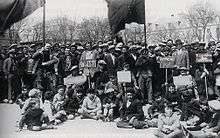Confédération générale du travail unitaire
|
Demonstration of CGTU construction workers, Concarneau, 1929 | |
| Full name | United General Confederation of Labour |
|---|---|
| Founded | June 1922 |
| Date dissolved | 1936 |
| Merged | General Confederation of Labour |
| Key people | Gaston Monmousseau |
| Country | France |
The Confédération générale du travail unitaire, or CGTU (United General Confederation of Labor) was a trade union confederation in France that at first included anarcho-syndicalists and soon became aligned with the French Communist Party. It was founded in 1922 as a confederation of radical unions that had left the socialist-dominated General Confederation of Labour (CGT), and in 1936 merged back into the CGT.
Foundation
The CGTU emerged from a split in the General Confederation of Labour (CGT: Confédération générale du travail), which had been torn by confrontations between socialist members of the French Section of the Workers' International (SFIO: Section Française de l'Internationale Ouvrière) and the more radical anarcho-syndicalists and members of the French Communist Party (PCF: Parti communiste français).[1] The CGTU took the majority of the CGT with it.[2] Initially the syndicalists and anarchists outnumbered the communists.[3]
Joseph Tommasi, a member of the PCF executive committee, attended the congress in Saint-Étienne on 25 June – 1 July 1922 at which the syndicates, unions and federations that had been excluded from the CGT founded the CGTU. The dynamic new organization was attached to peace and to the anti-imperialist and anti-colonialist struggle.[4] As a member of the anarcho-syndicalist minority of the CGT, Gaston Monmousseau became General Secretary of the CGTU, a position he held until 1933.[5]
History
Over the first two or three years many of the syndicalists joined the communist movement, including leaders such as Alfred Rosmer and Pierre Monatte. Later the syndicalists became disillusioned with the control exerted by Moscow over the party, and the Trotskyite purges.[3] Marie Guillot founded a new "unitary" confederation of teachers, with its first confederal Congress held at Saint-Étienne in June 1922. Marie Guillot took an intermediate position in the continuum of revolutionary syndicalism, while recognizing the merits of the Soviet Revolution.[6] Guillot was appointed to the confederal Bureau of the CGTU after the withdrawal of her colleague Louis Bouët. This was the first time a woman was part of the Confederation Office, according to the L'Humanité.[7] The cohabitation of revolutionary syndicalists with supporters of unconditional international centralism did not last long, and Guillot resigned from her responsibilities within the CGTU in July 1923.
In November 1922 Monmousseau represented the CGTU at the second congress of the Red International of Trade Unions (Profintern) in Moscow.[5] Pierre Semard, a leader in the PCF, played an important role in the debate between Communists and Anarcho-Syndicalists over the role of the CGTU at its Bourges Congress in September 1923. Semard proposed a motion, passed by a great majority, that the CGTU would commit itself to a tireless struggle for the defense of workers. This was a victory for the Communist faction.[8] In 1923 CGTU became a Profintern affiliate.[1] The communist fully controlled the CGTU after 1924. They introduced changes to the original constitution. Union officials were now eligible for reelection, votes were proportion to the number of union members represented. Efforts, generally unsuccessful, were made to replace local organizations by regional ones, with officials loyal to the party rather than to their local base.[2]
Lucie Colliard was a deputy member of the PCF's 24-member steering committee (CD: Comité Directeur) from 1922 to 1924.[9] She was a member of the female secretariat of the CGTU from 1923 to 1925.[10] In 1926, some of the CGTU members left to create the Confédération Générale du Travail-Syndicaliste Révolutionnaire (CGT-SR).[1] Some syndicalists stayed with the CGTU and others returned to the CGT.[2] Marie Mayoux and her husband François Mayoux, leaders of the teachers' union, were expelled from the PCF at the party congress held in Paris on 16–19 October 1922 as "unrepentant sydicalists".[11] In 1929 they were also expelled from the CGTU.[12]
The CGTU membership steadily declined in comparison to the CGT due to internal disagreements, ineffective strikes and troubles within the Communist Party.[2] During the Popular Front period the CGTU merged back into CGT.[1] Monmousseau participated in founding the reunified CGT in 1936.[13]
References
- 1 2 3 4 Lazitch 1986, p. xxxi.
- 1 2 3 4 Lorwin 1954, p. 58.
- 1 2 Lorwin 1954, p. 57.
- ↑ Simon 1990, p. 849.
- 1 2 Pottier 2013.
- ↑ Dreyfus 1995, pp. 126–128.
- ↑ 2 August 1922, Compte-rendu du Congrès
- ↑ Marty 1944.
- ↑ Maitron 1989, p. 235.
- ↑ Riddell 2011, p. 572.
- ↑ Marie et François Mayoux, Ephéméride Anarchiste.
- ↑ Monmousseau, Gaston, Great Soviet Encyclopedia.
Sources
- "Colliard (1877-1961)". La Bataille socialiste (in French). Retrieved 2014-12-12.
- Dreyfus, Michel (1995). Histoire de la C. G. T.: Cent ans de syndicalisme en France. Editions Complexe. ISBN 978-2-87027-574-0. Retrieved 2013-09-15.
- Lazitch, Branko (1986). Biographical Dictionary of the Comintern. Stanford: The Hoover Institution Press.
- Lorwin, Val Rogin (1954-01-01). The French Labor Movement. Harvard University Press. ISBN 978-0-674-32200-4. Retrieved 2015-03-21.
- Maitron, Jean (1989). Communisme - Révolution Française. L'AGE D'HOMME. ISBN 978-2-8251-3407-8. Retrieved 2014-12-12.
- Marty, André (1944-08-22). "PIERRE SEMARD". Algiers. Retrieved 2015-03-21.
- "Marie et François Mayoux". Ephéméride Anarchiste (in French). Retrieved 2014-12-18.
- "Monmousseau, Gaston". The Great Soviet Encyclopedia, 3rd Edition (1970-1979). The Gale Group. 2010. Retrieved 2015-03-21.
- Pottier, Georges-François (2013). "IL Y A 130 ANS NAISSAIT EN TOURAINE – GASTON MONMOUSSEAU (1883-1960) SYNDICALISTE, HOMME POLITIQUE ET ÉCRIVAIN" (in French). Archives départementales d'Indre-et-Loire. Retrieved 2015-03-21.
- Riddell, John, ed. (2011-10-14). "Trade Unions". Toward the United Front: Proceedings of the Fourth Congress of the Communist International, 1922. BRILL. ISBN 90-04-20778-3. Retrieved 2014-12-18.
- Simon, Luis (1990). "L'Heritage Revolutionnaire de la C.G.T.". Hommage a Jaime Diaz-Rozzotto. Presses Univ. Franche-Comté. GGKEY:7AF9XRNU0JG. Retrieved 2015-03-14.
